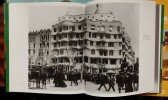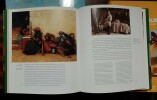3 books for « sala teresa m o l v »Edit
-
Topics
1900 (2)
Barcelona (3)
Painting (1)
Spanish (2)
-
Countries
Belgium (2)
France (1)
Barcelona 1900,
, Mercatorfonds, 2007, softcover ,Nederlands, 28 x 24 cm., 192pp., 160 illustraties in kleur. ISBN 9789061537564.
Barcelona is rond 1900 een stad met vele gezichten: artistieke en culturele bloei gaan gepaard met hevige sociale en politieke spanningen. Enerzijds kent de stad een enorme grandeur met de Teatre del Liceu als symbool van de rijke bourgeoisie, de weldadige stadsarchitectuur van Antoni Gaudi en Lluis Domenech i Montaner en de art-nouveau-interieurs. Er is een levendig artistiek klimaat rond de Sala Pares, waar avant-gardekunstenaars exposeren die hun inspiratie in Parijs hebben opgedaan, het cafe Els Quatre Gats, waar Picasso, Rusinol en hun vrienden uit de boheme samenkomen, en de kunstenaarskolonie Sitges. Jonge kunstenaars als Isidre Nonell en Ramon Casas doen van zich spreken en weten in hun kunstwerken het modernisme te koppelen aan sociale bevlogenheid. Er vindt, op basis van het ontwerp van civiel ingenieur Ildefonso Cerda, een ingrijpende en vooruitstrevende stadsuitbreiding plaats. Maar tegelijkertijd kampt de stad met een intensieve industrialisatie die de populatie in een snel tempo doet groeien. Barcelona wordt een moderne metropool. Alle spanningen culmineren in de ???Tragische Week?? . De stad staat in brand maar tussen de puinhopen wordt gebouwd aan La Sagrada Familia van Gaudi, de ???kathedraal van de armen?? , een teken van hoop. Barcelona 1900 schept een beeld van de artistieke diversiteit in Barcelona en voert de lezer door de stad, van de Ramblas via het Palau de la Musica Catalana naar Gaudi?? s kathedraal. Op deze ???wandelroute?? presenteert Barcelona zich in haar schilderijen, tekeningen, sculpturen, meubels, sieraden en maquettes. Nieuw boek.
Barcelona 1900,
, Mercatorfonds, 2007, Hardcover with dust jacket, 28 x 24 cm., 192pp., 160 full colour illustrations. ISBN 9780801446573.
At the dawn of the twentieth century Barcelona was a city of many aspects, its artistic and cultural growth being matched by strong political and social tensions. Thus it was that the city displayed extraordinary grandeur with its Teatre del Liceu, a symbol of the well-to-do bourgeoisie, with the delightful urban architecture of Antoni Gaudi and Lluis Domenech i Montaner, or indeed with the Art Nouveau interiors. Artistic life flourished in many places: in the Sala Pares, where avant-garde artists who had studied in Paris exhibited their work; in the Els Quatre Gats, where Picasso, Rusinol and their Bohemian friends met regularly, but also the artists?? colony in Sitges. Young talents like Isidre Nonell or Ramon Casas were making a name for themselves, with their flair for combining modernism with social realities in their work. In the same period Barcelona was undergoing an urban expansion which was both impressive and innovative: l?? Eixample, based on the designs of the engineer Ildefonso Cerda. But at the same time the city was facing intense industrialisation, which in turn brought with it heavy demographic pressures. Thus Barcelona was turning into a modern metropolis. The tension reached its paroxysm in 1909, during the ???Semana tragica???. The town was in flames but in the midst of the rubble people busied themselves with trying to construct Gaudi?? s Holy Family, the ???Cathedral of the Poor???, a sign of hope. Barcelona 1900 offers a glimpse of the artistic diversity of the city during the ???Golden Age??? which was the end of the nineteenth century, leading the reader from the Ramblas to Gaudi?? s cathedral, via the Palau de la Musica Catalana. All along this ???walking trail??? Barcelona is revealed in pictures, drawings, sculptures, furniture, jewellery and models. New book.
Barcelone 1900
Bruxelles, Fonds Mercator/Amsterdam, Van Gogh Museum, 2007, 25 x 28,5, 214 pages sous percaline éditeur et jaquette illustrée. Iconographie noir & blanc et couleurs. Catalogue publié à l'occasion de l'exposition présentée au Van Gogh Museum, Amsterdam, du 21 septembre 2007 au 20 janvier 2008.
Bon état.
 Write to the booksellers
Write to the booksellers



